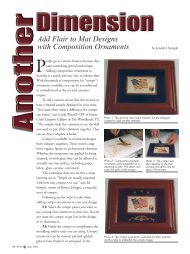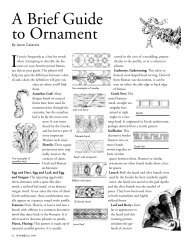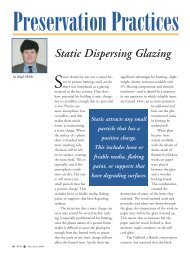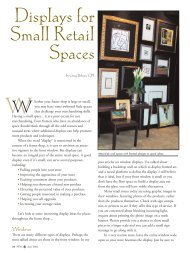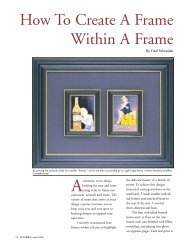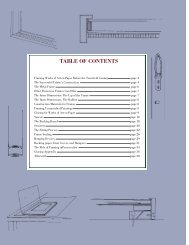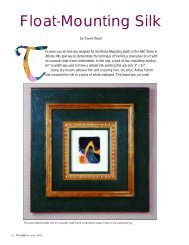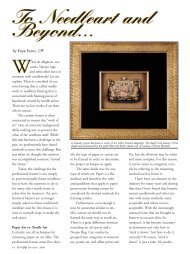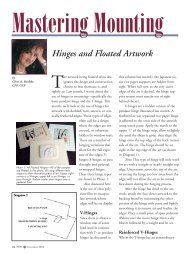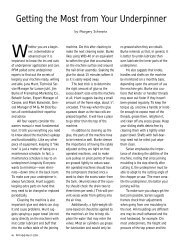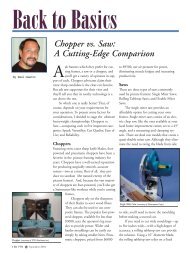Close-framed Photographs - Picture Framing Magazine
Close-framed Photographs - Picture Framing Magazine
Close-framed Photographs - Picture Framing Magazine
Create successful ePaper yourself
Turn your PDF publications into a flip-book with our unique Google optimized e-Paper software.
Lessons from the<br />
Arts and Crafts<br />
Movement<br />
Period Guidance<br />
A 1906 manual for professional picture framers instructed<br />
that “Frames for…photographs…are now principally<br />
made of [black and brown stained] oaks all finished in the<br />
dead [flat], and used in most cases close up to the picture<br />
without mats. The frames are used broad, yet very thin<br />
through, and the ornaments, if any, consist of delicate<br />
tracery of small classical designs, the same color as the<br />
frame.”<br />
House Beautiful advised in 1902, “Large photographs…may<br />
be <strong>framed</strong> in broad flat oak or gold moldings,<br />
without any mat or margin. The width of the frame<br />
makes up for the mat.”<br />
A 1912 article in The School Arts<br />
<strong>Magazine</strong> suggested that framing close was<br />
so popular as to be in danger of overuse:<br />
“Some decorators go so far as to say, 'Mat<br />
no picture,' but it is to a certain extent a<br />
matter of taste, and there are cases where<br />
an exception seems wise.” The writer<br />
offered some exceptions, such as “a small<br />
picture which is like a jewel and requires a<br />
setting. A picture with a great deal of<br />
action seems sometimes to require a mat.” The framers'<br />
manual adds, “Every framer knows that close framing is<br />
only effective where the subject is large enough and bold<br />
enough in outline to bear such severe treatment.”<br />
The Arts and Crafts Movement Unity Ideal<br />
The basis for this approach is the Arts and Crafts Movement's<br />
overriding concern for the unity of the arts. The<br />
leading reformers, such as John Ruskin and William Morris,<br />
held that throughout time, where allowed to thrive<br />
without tyrannical conditions—including the miserable<br />
industrialized conditions of their own day—all the arts,<br />
An original Curtis photo, “Canyon de Chelly,” was <strong>framed</strong> by the<br />
photographer around 1910 without matting in the Arts and Crafts<br />
style of the time.<br />
A recent photogravure of “Canyon de<br />
Chelly” by Mountain Hawk was close<strong>framed</strong><br />
using a compound or stacked frame.<br />
A flat frame with beading on the sight edge<br />
was used with ovolo cap moulding.<br />
from the most utilitarian handcrafts to the most refined<br />
and purely spiritual paintings and sculptures, had been<br />
practiced together and had worked in harmony. With<br />
architecture as the mother of the arts, everything from<br />
metalsmithing to pictures—the first pictures being<br />
murals—had been in service, and subordinate to buildings.<br />
Unity, it was argued, is absolutely critical to the vitality<br />
of the arts. Furthermore, the unity of the arts was<br />
inseparable from the unity of art and life, the arts being<br />
practiced by the whole people in every aspect of their<br />
lives. As Gustav Stickley, the leading promoter of Arts and<br />
Crafts ideas in America, put it, art is not “something apart<br />
October 2007_ PFM 63



